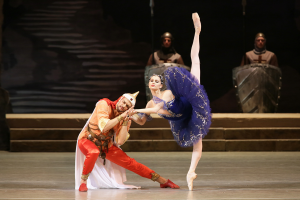
The Mariinsky Ballet performing “Raymonda” at the Mariinsky Theater.
The Mariinsky Ballet finally arrived on the East Coast of the United States 118 years after its initial apparition in a revival of “Raymonda,” a classical piece of the Russian ballet repertoire, at the Kennedy Center from Feb. 23 to 28. The celebrated St. Petersburg company remains loyal to tradition with its performance, showing zero intention of modernizing the piece. Exemplifying the rich history of ballet, the Mariinsky succeeds in upholding the conventions of rigidity and elegance in its process of storytelling.
Choreographed by the legendary Marius Petipa with a score by Alexander Glazunov, the three-act ballet revolves around an interrupted courtship that takes place in medieval Provence. The titular princess Raymonda (Yekaterina Kondaurova) awaits the return of her fiance, knight Jean de Brienne, from a crusade led by King Andrew of Hungary. In the meantime, a Saracen chief, Abderakhman, attempts to lure Raymonda away with expensive gifts. When this strategy fails, Abderakhman orders his entourage of Arab and Spanish panaderos dancers to abduct the princess. Amid chasing musical measures and Moorish dances blended with gipsy-style flamenco duos, the second act offers perhaps the most sensuous, while still elegant, tune of the show.
As audiences familiar with the play know, the conclusion of “Raymonda” sacrifices intrigue for a series of Hungarian national dances, including wild czardas and mazurkas. The Mariinsky’s rendition of this is masterful. The grand pas hongrois exemplifies an air of solemn fantasy that permeates throughout the entire performance. The merit of this closing triumph goes mostly to Kondaurova, who closed off the ballet by showcasing her flawless authority and the silken steeliness of her pointework in a variation.
Kondaurova, a graduate of the Vagonova Ballet Academy, sparkled onstage throughout the show. The spare set, designed by the visionary Simon Virsaladze, brilliantly complements Kondaurova’s tapered, elongated form. Dazzling tutus, exhibiting the pure colors of light peach, blue and white, help transform Raymonda into an angelic vision. Her grand developpe a la seconde, revealed in a blue tutu, seems to prolong the dancer’s physique in a sort of bridge connecting heaven and earth, contributing to Petipa’s overarching theme of spirituality.
The choice of light colors for the sets along with the dancers’ precision serve to create “a time capsule,” according to Guy Speilmann, a Georgetown University French professor who teaches a course on performance in the Early Modern era. “The whole production is very faithful to the way in which people would have done it the 19th century,” he said.
Speilmann added that the lavish costumes, the flats used for the set, the troubadour style and sprightly meters all converge in forming “the narrative illusion of history twice removed.” As a result, audience members witness an authentic, 19th-century spectacle on courtly life and love in the late Middle Ages.
From Korsuntsev’s effortless sailing through a repeated sequence of impeccable tours en l’air to the impressive high jumps, the performers’ mastery of the art of ballet is highly evident. Despite a few problems with heavy feet, the soloists and the coryphees also showcase precision. This precise organization, ranging from the form of the dancers to the performers’ spontaneous bows, is a trademark of the Mariinsky. Though old-fashioned in comparison to contemporary dance, the performance’s aura of detached elegance is formidable.
A viewer unfamiliar with ballet may initially be put off by the unbalanced rhythm of the story, which oscillates between condensed sequences of action and descriptive lulls in narration. There is even a sense of slowness and motionlessness in the variations upon which Glazunov’s music is structured. However, this rigidity does not happen by chance, but is rather intentional, representing a recurring motif in Petipa’s works. With impeccable technical mastery, the Mariinsky’s performance of “Raymonda” is graceful and brings audiences back to the golden age of ballet.



















